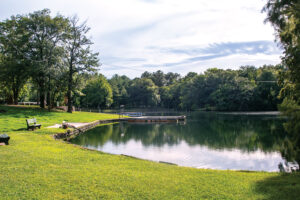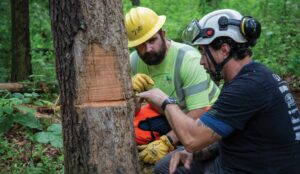 Each year on the last Monday in May, the hauntingly beautiful scenes of rows of pristine white grave markers in our National Cemeteries appear in newspapers and on television reminding us it is Memorial Day. Usually the graves are decorated with American flags, helping us recall and honor those who perished in defense of our freedom. (Veterans Day on November 11 honors everyone who has served in the armed forces.)
Each year on the last Monday in May, the hauntingly beautiful scenes of rows of pristine white grave markers in our National Cemeteries appear in newspapers and on television reminding us it is Memorial Day. Usually the graves are decorated with American flags, helping us recall and honor those who perished in defense of our freedom. (Veterans Day on November 11 honors everyone who has served in the armed forces.)
However, it is an actual visit to any of the 131 National Veterans Cemeteries that leaves an indelible memory. The seemingly unending rows of gravestones that follow the contour of the land muster up feelings of deep sadness and serenity.
Yet, there is also an unexpected pleasure that comes with the realization that appropriate care is being given to the grave of each soldier interred. No blade of grass seems uncut, and the grave markers appear so white they may have been just recently placed. A sense of dignity pervades.
Shawn Baumgarter, the Superintendent of the Abraham Lincoln National Cemetery in Elwood, Ill., says it is easy to understand why each cemetery appears so manicured. “We have the honor each day to serve our veterans by taking special care of their graves for eternity. We are the keepers of a national shrine,” he says speaking about himself and his staff.
Baumgarter feels an intense loyalty to the families of veterans he meets, often during one of the most difficult times in their lives. “Our objective is to relieve them of a tremendous burden during the planning and burial process,” he says. “We give them satisfaction and a sense of relief when they see our cemeteries and realize their loved one will always be taken care of in a manner in which they can take pride and comfort forever.”
Origin of National Cemeteries for veterans
 The concept of a veterans’ cemetery originated during the Civil War. Due to mounting war casualties, on July 17, 1862, Congress empowered President Abraham Lincoln “to purchase cemetery grounds… to be used as a national cemetery for the soldiers who shall die in the service of the country.”
The concept of a veterans’ cemetery originated during the Civil War. Due to mounting war casualties, on July 17, 1862, Congress empowered President Abraham Lincoln “to purchase cemetery grounds… to be used as a national cemetery for the soldiers who shall die in the service of the country.”
Today the National Cemetery Association (NCA), an agency of the U. S. Department of Veterans Affairs, is responsible for the cemeteries. In Illinois five of the ten National Cemeteries in the state remain open for additional burials.
Among the first 14 national cemeteries established in 1862 was Camp Butler, located in Springfield. At the time, the site was a Union Civil War training camp and Confederate prison.
Abraham Lincoln National Cemetery in Elwood opened in 1999, and is the second largest national cemetery. Consisting of almost 1,000 acres, it can accommodate 400,000 graves. Presently 40,000 service members are interred there.
Origin of Memorial Day
The idea for a national memorial day to honor the nation’s war dead is credited to Union Major General John A. Logan who was born in 1826 in what is now Murphysboro. After the war and as national commander of the Grand Army of the Republic, he proclaimed that “the 30th of May, 1868, is designated for the purpose of strewing with flowers, or otherwise decorating the graves of comrades who died in defense of their country during the late rebellion, and whose bodies now lie in almost every city, village and hamlet churchyard in the land.”
Gen. Logan’s order for his posts included the words that the graves should be decorated “with the choicest flowers of springtime,” and that “we should guard their graves with sacred vigilance. … Let no neglect, no ravages of time, testify to the present or to the coming generations that we have forgotten as a people the cost of a free and undivided republic.”
Public unaware
Baumgarter says one of his biggest challenges facing the NCA is getting the information out to veterans that they, along with their dependents, can be buried in a national cemetery at no cost. “I would encourage all veterans to visit a national cemetery and learn what we can do for them and their family,” he says.
Facts about Memorial Day
• Memorial Day was originally named Decoration Day due to the custom that had developed soon after the Civil War of decorating Union and Confederate graves with flowers.
• Carbondale, Ill. claims to have had the first Memorial Day ceremony on April 29, 1866. However, at least 25 other places have made a similar claim.
• Initially the date of May 30 was chosen because it was not the anniversary of any particular battle. It is also thought to have been chosen because flowers would be in bloom nationwide. Subsequently the date has been moved to the last Monday in May to create a three-day weekend holiday.
• Since 1862, more than 3.8 million burials have taken place in National Cemeteries.
• Arlington National Cemetery in Arlington, Va. and Soldiers’ and Airmen’s Home National Cemetery in Washington, D.C., are under the jurisdiction of the Department of the Army, and not the NCA.
• The American Battle Monuments Commission (ABMC) oversees 25 permanent American cemeteries on foreign soil.
• Some states have established their own veterans’ cemeteries not associated with the NCA. The Sunset Cemetery in Quincy is the Illinois state veterans cemetery.
Illinois Veterans Cemeteries
The Department of Veterans Affairs’ (VA) National Cemetery Administration lists the following National Cemeteries in Illinois:
Abraham Lincoln National Cemetery, Elwood*
Alton National Cemetery, Alton **
Camp Butler National Cemetery, Springfield*
Confederate Mounds at, Oak Woods, Chicago
Danville National Cemetery, Danville*
Mound City National Cemetery, Mound City*
North Alton Confederate Cemetery, Alton
Quincy National Cemetery, Quincy
Rock Island Confederate Cemetery, Rock Island
Rock Island National Cemetery, Rock Island*
*open for burial
**open for cremation only









